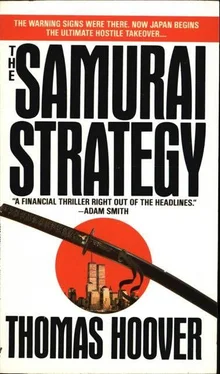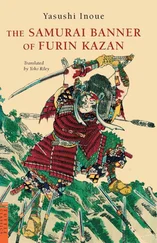Thomas Hoover - The samurai strategy
Здесь есть возможность читать онлайн «Thomas Hoover - The samurai strategy» весь текст электронной книги совершенно бесплатно (целиком полную версию без сокращений). В некоторых случаях можно слушать аудио, скачать через торрент в формате fb2 и присутствует краткое содержание. Жанр: Триллер, на английском языке. Описание произведения, (предисловие) а так же отзывы посетителей доступны на портале библиотеки ЛибКат.
- Название:The samurai strategy
- Автор:
- Жанр:
- Год:неизвестен
- ISBN:нет данных
- Рейтинг книги:5 / 5. Голосов: 1
-
Избранное:Добавить в избранное
- Отзывы:
-
Ваша оценка:
- 100
- 1
- 2
- 3
- 4
- 5
The samurai strategy: краткое содержание, описание и аннотация
Предлагаем к чтению аннотацию, описание, краткое содержание или предисловие (зависит от того, что написал сам автор книги «The samurai strategy»). Если вы не нашли необходимую информацию о книге — напишите в комментариях, мы постараемся отыскать её.
The samurai strategy — читать онлайн бесплатно полную книгу (весь текст) целиком
Ниже представлен текст книги, разбитый по страницам. Система сохранения места последней прочитанной страницы, позволяет с удобством читать онлайн бесплатно книгу «The samurai strategy», без необходимости каждый раз заново искать на чём Вы остановились. Поставьте закладку, и сможете в любой момент перейти на страницу, на которой закончили чтение.
Интервал:
Закладка:
Funny, but every once in a while she'd stop everything and watch the kids in the playground down there. What to do? The damned shadows were growing longer by the minute. Maybe Dave wasn't so bad. Trouble was, he needed mothering too.
Think about it tomorrow, Scarlet. She sighed, poured herself a cognac, and headed for the bedroom to get Allan's coat.
After she'd put him on the elevator, she came back and checked out Dave, now slouched in the big chair by the lamp, his eyes closed. He looked positively enticing, and she sounded his name quietly. Nothing. Then she realized he was sound asleep. Snoring.
The bastard. This was it. She grabbed his coat, pushed him out the door, poured herself another cognac, and plopped down in the living room to think.
All right, Allan. You've got a deal. Could be you're on to something. I seem to remember there's a conference in Kyoto starting week after next on supercomputers. Kenji Asano will probably show. Good time to catch him off guard and try to find out what's suddenly so hush-hush.
Yes, by God, I'll do it.
She didn't bother with any of Allan Stern's funding. This trip would be strictly off-the-record. She wrapped up some loose ends, called a few people she knew in Tokyo, lined up half a dozen interviews that might be helpful on the new book, packed her toothbrush and tape recorder, and boarded a Northwest flight for Narita.
She had no idea then, of course, but she was Alice, dropping down the rabbit hole. A fortnight later she was dining with the Emperor of Japan.
CHAPTER FOUR
Allan Stem's alarm about Japan's semiconductor challenge reflected only part of the picture. There was also plenty going on with Japanese research in addition to information processing. Superconductivity was getting a big push, as was biotechnology, optoelectronics, advanced materials. Although we in the West think of Japan as a newcomer in the high-tech sweepstakes, it actually has a long tradition of innovation. A typical for-instance: in the area of advanced materials those of us hooked on swords know the Japanese were already creating "new materials" hundreds of years ago that still haven't been bettered. Back then it was flawless steel for katana blades; today it's, say, gallium arsenide crystals for laser-driven semiconductors. How, one might inquire, did all this expertise come about?
To stick to materials research, if you think a moment you realize it's a discipline that actually must have begun in the latter days of the Stone Age. "High technology" in those times meant figuring new ways to use fire and clay to create something nature had neglected to provide. Not integrated circuits, but a decent water pot.
And the Japanese have been making terrific pots for a thousand years. As it happens, some historians claim the very first Japanese pottery was made in the province of Tamba, near Kyoto. Why mention this? Because, then as now, technology and politics had a way of getting mixed together in Japan, and Tamba was a perfect example. Tamba's artisans made great use of a special oven known as a climbing-chambered kiln. Whereas ceramics kilns elsewhere in the country were narrow and high, Tamba's climbing-hill chambers were wide and low, thereby allowing the fire to touch the clay directly. The result was a rugged, flame-seared stoneware that pleased the manly eye-powerful earthy grays, burnt reds, greenish-browns, all with a hard metallic luster. Thus Tamba was a locale much frequented by the warrior shoguns.
Which may be why Tamba province has another claim to history as well. It is the location of the one-time warrior castle- fortress of Sasayama, once a regional command post of the Tokugawa strongmen in Tokyo. You won't find overly much about Sasayama in the usual guidebooks, since it has the kind of history that's more interesting to Japanese than to tourists. The place has no gaudy vermilion temples, no bronze Buddhas ten stories high. Fact is, very little remains of the fortress itself these days except for a wide moat, green with lotuses, and a few stone walls lined with cherry trees that blossom an exquisite white for a few breathtaking moments each spring.
Although the castle is now burned down, a few homes of the samurai retainers of its various warlords remain. If you stand on the rocky edge of the moat at its southwest corner and look down through the cherry trees, you'll see an old-style house built some two hundred years ago by the twelfth daimyo of Sasayama for his most loyal retainer. Its walls of white plaster are interspersed with beams of dark wood, its thatch roof supported by the traditional ridgepole. Think of it as the home of the samurai most trusted, the guardian of the gates, the warrior nearest the fount of power.
Perhaps it will not seem surprising, therefore, that this ancient samurai residence, in the shogun stronghold closest to ancient Kyoto, was now home base for a powerful warrior of modern Japan. Matsuo Noda.
Samurai had once battled in Sasayama's streets; many's the time its castle had been stormed by raging armies; much blood had been shed and much honor lost. But the event that occurred in Sasayama precisely two weeks after Tamara Richardson's dinner in New York was a historical moment more important than any in its thousand years prior.
It began shortly after dawn, a cool September gray just ripening to pink over the mountains. The early sounds of morning-birdsong, the faint bell of the tofu seller, the steam whistle of the autumn sweet-potato vendor-were only beginning to intrude on the quiet. Noda was where he always was at this moment: on the veranda overlooking his personal garden, a classic Zen-style landscape whose central pond was circled by natural-appearing rocks, trees, bushes, paths. It was, of course, about as "natural" as those sculptured hedges at Versailles. In order to create the illusion of perspective and depth, the stones along the foreshore of the pond were bold, rugged, massively detailed, while those on the opposite side were dark, small, smooth-a little trick to make them seem farther away than they were.
It's a game heavy with nuance. For example, the stone footpath on the left side of the pond may look as if it goes on forever, but that's just part of the art: the stones get smaller toward the back, curving in and out among the azalea bushes till they make one last twist and disappear among the red pines and maples at the rear. Which trees, incidentally, have themselves been slightly dwarfed, again enhancing the illusion of distance, just as the back is deliberately shaggy and dark, like the beginnings of a forest that goes on for miles.
Noda's Zen garden, which deludes rational judgment by manipulating all the signposts we use to gauge distance and space, appeared to be limitless. The secret was that nothing actually ends: everything simply fades out and gets lost. It was a closed space that seemed for all the world as if it went on and on if you could only somehow see the rest of it. Yet peek only a few yards away, and you've got the mundane streets of sleepy Sasayama.
This special dawn, as a few frogs along the edge of the pond croaked into the brisk air, he knelt on the viewing veranda in a fine cotton morning robe, a yukata emblazoned with his family crest (an archaic Chinese ideogram meaning "courage") and began to center his mind. He'd left his Kyoto headquarters early Friday evening, skipping the usual after-hours-drinking obligation of Japanese executives and grabbing the eight-thirty San-in Express to Sonobe, where his limo waited to bring him the rest of the way home. Now he was up before daybreak and readying his usual morning ritual. As he sat there, gazing across the placid water dotted with lotuses at the foreshore and framed with willows at the far horizon, his silver hair contrasted with the marine blue of the robe to create a presence easily as striking as the garden itself.
Читать дальшеИнтервал:
Закладка:
Похожие книги на «The samurai strategy»
Представляем Вашему вниманию похожие книги на «The samurai strategy» списком для выбора. Мы отобрали схожую по названию и смыслу литературу в надежде предоставить читателям больше вариантов отыскать новые, интересные, ещё непрочитанные произведения.
Обсуждение, отзывы о книге «The samurai strategy» и просто собственные мнения читателей. Оставьте ваши комментарии, напишите, что Вы думаете о произведении, его смысле или главных героях. Укажите что конкретно понравилось, а что нет, и почему Вы так считаете.












